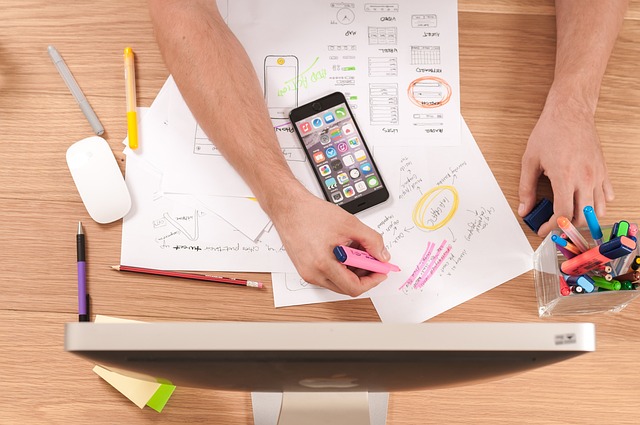Millions of people are buying smartphones for using various applications. As they use mobile software, the first thing that strikes the eye is the UI of the app. So, having an attractive design means a lot. The main goal of UI developers is to build a beautiful and user-friendly design that will engage more users.
Having an app alone is not enough; a business would want the users to download the app and use it time and again. 90% of the smartphone users have uninstalled the mobile applications due to poor performance. Users will not like to continue with an app if it has an unpleasant color combination or poor aesthetics. The latest UI design trends highlight the preferences of users and showcase key designs that will dominate screens in the upcoming year. Be sure to take a look for inspiration on user preferences!
Every UI developer has been asked many times, “What process do you follow to design a mobile app?” This article gives you a standard mobile app UI design process to follow.
What is the standard mobile app UI design process?
As we know what UI design is, the following is the complete process to provide an elegant UI experience to the users.
Concept of the product
Before we start with the mobile app design, it is essential to understand the concept of the product and its requirements. The product definition phase gives the foundation to the UI designers to think about the value and key aspects of the product to map the needs of the business and the users and sketch the design of the future product.
This phase ends up with a meeting where all the team players set an expectation. That covers the outline of the concept, the team structure, communication channels, etc.
Market Analysis
This step aims to analyze what a user needs and why they need it. The UI designers confirm that the team has the most accurate and realistic analysis. This phase of the mobile app UI design process includes:
User persona- These are fictional characters that represent multiple user types for your application. Once you design the product, you can consider these personas as real for your target audience.
A persona helps you to identify the real user problems and who is your target audience by answering the following questions:
- Who is your target audience?
- What is the behavioral pattern used by the users?
- What are the needs of the users?
- What issues are they currently facing within the given context?
Let’s take an example for a clear understanding of how a user persona is designed.
Steven John
Self-employed, owns a restaurant
Age: Mid 30s
Washington
Married
Upper-middle level income
Likes to play sports and workout
Needs and goals
Running a restaurant Steven does not like wasting time as he thinks time is money. He wants to meet new people and build relationships. Being a single business owner he needs to keep his professional bank account separately from his personal account. Steven wants to use both the accounts without much effort.
Behavioral Patterns
As he spends a lot of time in his business, he is habituated to use smart phones and is tech-savvy. He prefers to use multiple apps for quick work and he knows in and out of the applications.
“I hate the long queues in the bank and so I prefer online banking, as it is much less nerve-wracking.”
User stories– While user persona describes their life and patterns, user story describes how they use the app features in simple terms. It gets straight to the point of what the user needs. It describes the pain of the user, for example, how a user would feel about showing a credit card balance despite keeping a good credit score.
The example means that the user wants to pay the credit card outstanding balance, so the design team can more or less start with providing an instant access to pay the outstanding amount. The first thing a user sees is the option to check the balance and a quickest way to pay.
Storyboarding– A storyboard communicates the story through simple images in a sequence. It is a visual representation of how a user will interact with the UI while using a product. It’s the simplest way to outline the structure across multiple screens.
Creating Wireframes
Wireframes are the graphic structure of an app that contains elements like any blueprint of a construction site. It looks simple but it needs in-depth work by the UI/UX designers. It is a low-fidelity framework that targets the main information, sketch of the app design and the description of the user interface.
Wireframes help to see how your app actually functions, and acts as the backbone of the product that is often used for prototypes.
Prototypes
Prototypes are usually high fidelity and computer based that allows realistic user interactions unlike wireframes. It fits the final user interface as much as possible for a clear visual of the app. A prototype is an actual interaction experience either clickable or coded.
Visuals and Styles
Would you like to see an app without any color or shape? No right!
A mockup is the visual script of the product. A simple app cannot attract the users, it needs visual language that comprises color, shape, movement, etc. You cannot ignore colors and shapes while designing the app as it gives an elegant look, so choose the right color for each app design and get it tested by the QA team.
Testing
Testing is an essential step in the mobile app UI design process as it helps the team to understand whether the design would work well for their users. In addition, high-fidelity design testing provides accurate feedback from the end-users. The validation phase consists of testing procedures, completing routine operations, testing sessions with the target audience, surveys for capturing quality information.
While testing the product in the real world, there are multiple open-ended questions that you can add to get suggestions and opinions from the users.
Important Tips for Mobile App Design
There are certain tips to consider when creating a mobile app design. Let’s discuss each one of them in a separate section.
Color schemes
Color schemes are tested to see how attractive the app looks from the user’s point of view. The QA team could make a note of the same if any changes are needed while testing. Ensure to make necessary changes so that the users can get a better look and feel of the app.
Navigation
It is very crucial to pay attention to the mobile app navigation without any errors and bugs. Hassle-free navigation will attract more users, and they will be interested in using the app for a long time. On the other hand, users will get bored if you overload the app with extra elements.
Typography
Typography is an important skill in designing a mobile app. Text is what interests the users, along with the color schemes. The text should be clear, precise and readable, so always use the right font for convenient reading. In addition, keep adequate spaces between each line. In a few apps, you can see that the user can change the font, but it should be elegant and nifty.
Conclusion
Well, this is it! Mobile app designing is an ongoing process that will continue post-launch after you receive feedback from the users. There is no one-size-fits-all protocol as the product and concept differ each time you would like to design a mobile app. Use what works the best for you and the users.
Evolve with the latest technologies and create the best mobile app development process. The above process will ensure you a successful launch of your app.
If you have any queries related to the UI design process, feel free to contact us. We would love to help you create an elegant and stylish mobile app for your product.




